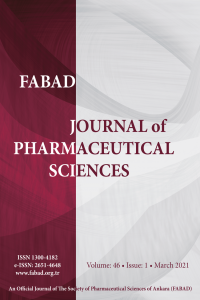Development and Characterization of Nanofiber Strip Containing Sertraline for Buccal Application
Development and Characterization of Nanofiber Strip Containing Sertraline for Buccal Application
___
- Al-Nimry, S. S., & Jaber, M. A. (2017). Preparation and optimization of sertraline hydrochloride tablets with improved dissolution through crystal modification. AAPS PharmSciTech, 18, 1190-1202. https://doi.org//10.1208/s12249-016-0586-z.
- Amariei, N., Manea, L. R., Bertea, A. P., Bertea, A., & Popa, A. (2017). The influence of polymer solution on the properties of electrospun 3D nanostructures. Mater Sci Eng, 209(1), 012092. https://doi. org//10.1088/1757-899X/209/1/012092.
- ISSN: 1300-4182
- Yayın Aralığı: Yılda 3 Sayı
- Başlangıç: 2005
- Yayıncı: FABAD Ankara Eczacılık Bilimleri Derneği
Metabolomic Studies in Girls With Central and Peripheral Precocious Puberty
Aylin BALCI ÖZYURT, Tuba REÇBER, Emirhan NEMUTLU, Derya BULUŞ, Sedef KIR, Belma KOÇER GÜMÜŞEL, Pınar ERKEKOĞLU
NLRP3 expression in peripheral blood mononuclear cells of patients with rheumatoid arthritis
Sezen YILMAZ SARIALTIN, Orhan KÜÇÜKŞAHİN, Cemil NURAL, Leyla Didem KOZACI, Pınar KAYGIN, Gülçin GÜLER ŞİMŞEK, Serpil OĞUZTÜZÜN, Tülay ÇOBAN
Development and Characterization of Nanofiber Strip Containing Sertraline for Buccal Application
Kutsal ÖZCAN, Sibel İLBASMIŞ TAMER, Eylül Su SARAL ACARCA
Kamlesh J WADHER, Vaishnavi RAUT, Keshav HİRAVE, Sagar TRİVEDİ, Milind UMEKAR
Drug Administration via Feeding Tube in Intensive Care Unit: A Cross-sectional Study
Nursel SURMELİOGLU, Yaren İLERİ, H Murat GÜNDÜZ, Dilek ÖZCENGİZ
Mucoadhesive Drug Delivery Systems for Pediatric and Geriatric Patients
Arya RAİ, Shristhi Sohan RAWAT, Ritu RATHİ, Deepika RAİNA, Oluwatoyin A. ODEKU, Inderbir SİNGH
